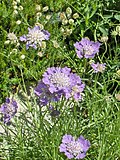Scabiosa
| Scabiosa subsp. var. | Scabious | |||||||||||||||||||||||||||||||||||||||||||||||||||||||
|---|---|---|---|---|---|---|---|---|---|---|---|---|---|---|---|---|---|---|---|---|---|---|---|---|---|---|---|---|---|---|---|---|---|---|---|---|---|---|---|---|---|---|---|---|---|---|---|---|---|---|---|---|---|---|---|---|

|
|
| ||||||||||||||||||||||||||||||||||||||||||||||||||||||
| ||||||||||||||||||||||||||||||||||||||||||||||||||||||||
Scabiosa (pronounced /skeɪbiˈoʊsə/)[1] is a genus in the teasel Family Dipsacaceae of flowering plants. Many of the species in this genus have common names that include the word scabious; however some plants commonly known as scabious are currently classified in related genera such as Knautia and Succisa; at least some of these were formerly placed in Scabiosa. Another common name for members of this genus is pincushion flowers.
Members of this genus are native to Europe and Asia. Some species of Scabiosa, notably small scabious (S. columbaria) and Mediterranean sweet scabious (S. atropurpurea) have been developed into cultivars for gardeners.
Scabiosa plants have many small flowers of soft lavender blue, lilac or creamy white colour borne in a single head on a tall stalk. Scabious flowers are nectar rich and attract a variety of insects including Lepidoptera such as the Six-spot Burnet moth. Scabiosa species are also used as food plants by the larvae of some Lepidoptera species including Grey Pug.
| Standard Cyclopedia of Horticulture |
|---|
|
Scabiosa (Latin, itch, referring to medicinal use). Dipsacaceae. Scabious. Mourning Bride. Annual or perennial herbs, their base more or less woody, comprising some of the showy and commonly cultivated garden flowers. Leaves entire, dentate-lobate or dissected: heads terminal, depressed subglobose or ovoid-conical, pedunculate or rarely sessile in a dichotomous infl.; bracts of the involucre l-2-rowed, herbaceous: fls. blue, rose, yellowish, or white; calyx bristly; corolla-limb 4-5-cleft, subequal or frequently oblique or 2-lipped; stamens 4, very rarely 2: achene adnate to the involucel at the base or up to the middle.—About 70 species, Eu., Asia, and Afr., rare in the tropics. In any moderately good garden soil a succession of flowers is produced from June until frost. The flowers are very serviceable for cutting purposes. Propagated by seed or division. Many of the perennial species act like biennials in cultivation, and often flower the first year from seed. S. atropurpurea is a common garden annual, of easy cultivation from seed. S. alpina, Linn. –Cephalaria alpina, Schrad. — S. elata, Hornem. –Cephalaria tatarica, Schrad. —S. lutea, Hort., is a perennial growing 5-7 ft. high : fls. yellow, not known botanically. Var. gigantea, Hort., is also offered in the trade. —S. tatarica, Linn. –Cephalaria tatarica, Schrad. CH
|
Cultivation
Propagation
Pests and diseases
Species
Among others:
- Scabiosa atropurpurea - Mourning bride, Egyptian rose, Mournful widow, Mediterranean sweet scabious. A hybrid cultivar?
- Scabiosa canescens - Fragrant scabious
- Scabiosa caucasica - Caucasian pincushion flower
- Scabiosa columbaria - Pigeon scabious, Pincushion flower, Small scabious, Dove pincushion; found wild on chalk downland in SE England
- Scabiosa graminifolia
- Scabiosa incisa
- Scabiosa lucida - Glossy scabious
- Scabiosa maritima
- Scabiosa minoana
- Scabiosa ochroleuca - Yellow scabious, Cream pincushions
- Scabiosa palaestrina - Balkan pincushions
- Scabiosa prolifera - Carmel daisy
- Scabiosa stellata - Sweet scabious, starflower pincushions, Paper moon (variety).
- Scabiosa triandra - Southern scabious
- Scabiosa vestina
Gallery
References
- ↑ Sunset Western Garden Book, 1995:606–607
- Standard Cyclopedia of Horticulture, by L. H. Bailey, MacMillan Co., 1963
External links
- w:Scabiosa. Some of the material on this page may be from Wikipedia, under the Creative Commons license.
- Scabiosa QR Code (Size 50, 100, 200, 500)



